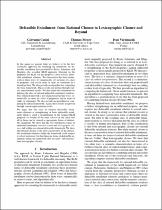 ResearchSpace
ResearchSpace
Defeasible entailment: From rational closure to lexicographic closure and beyond
JavaScript is disabled for your browser. Some features of this site may not work without it.
- ResearchSpace
- →
- Research Publications/Outputs
- →
- Conference Publications
- →
- View Item
| dc.contributor.author |
Casini, G

|
|
| dc.contributor.author |
Meyer, T

|
|
| dc.contributor.author |
Varzinczak, I

|
|
| dc.date.accessioned | 2019-03-26T06:40:37Z | |
| dc.date.available | 2019-03-26T06:40:37Z | |
| dc.date.issued | 2018-10 | |
| dc.identifier.citation | Casini, G., Meyer, T. and Varzinczak, I. 2018. Defeasible entailment: From rational closure to lexicographic closure and beyond. 17th International Workshop on Non-Monotonic Reasoning (NMR) 2018, 27-29 October 2018, Arizona, USA, pp. 109-118 | en_US |
| dc.identifier.uri | http://www4.uma.pt/nmr2018/NMR2018Proceedings.pdf | |
| dc.identifier.uri | http://hdl.handle.net/10204/10857 | |
| dc.description | Conference paper presented at the 17th International Workshop on Non-Monotonic Reasoning (NMR) 2018, 27-29 October 2018, Arizona, USA | en_US |
| dc.description.abstract | In this paper we present what we believe to be the first systematic approach for extending the framework for defeasible entailment first presented by Kraus, Lehmann, and Magidor—the so-called KLM approach. Drawing on the properties for KLM, we first propose a class of basic defeasible entailment relations. We characterise this basic framework in three ways: (i) semantically, (ii) in terms of a class of properties, and (iii) in terms of ranks on statements in a knowlege base. We also provide an algorithm for computing the basic framework. These results are proved through various representation results. We then refine this framework by defining the class of rational defeasible entailment relations. This refined framework is also characterised in thee ways: semantically, in terms of a class of properties, and in terms of ranks on statements. We also provide an algorithm for computing the refined framework. Again, these results are proved through various representation results. We argue that the class of rational defeasible entailment relations—a strengthening of basic defeasible entailment which is itself a strengthening of the original KLM proposal—is worthy of the term rational in the sense that all of them can be viewed as appropriate forms of defeasible entailment. We show that the two well-known forms of defeasible entailment, rational closure and lexicographic closure, fall within our rational defeasible framework. We show that rational closure is the most conservative of the defeasible entailment relations within the framework (with respect to subset inclusion), but that there are forms of defeasible entailment within our framework that are more “adventurous” than lexicographic closure. | en_US |
| dc.language.iso | en | en_US |
| dc.relation.ispartofseries | Worklist;22107 | |
| dc.subject | Defeasible Entailment | en_US |
| dc.subject | KLM approach | en_US |
| dc.subject | Rational closure | en_US |
| dc.subject | Lexicographic closure | en_US |
| dc.title | Defeasible entailment: From rational closure to lexicographic closure and beyond | en_US |
| dc.type | Conference Presentation | en_US |
| dc.identifier.apacitation | Casini, G., Meyer, T., & Varzinczak, I. (2018). Defeasible entailment: From rational closure to lexicographic closure and beyond. http://hdl.handle.net/10204/10857 | en_ZA |
| dc.identifier.chicagocitation | Casini, G, T Meyer, and I Varzinczak. "Defeasible entailment: From rational closure to lexicographic closure and beyond." (2018): http://hdl.handle.net/10204/10857 | en_ZA |
| dc.identifier.vancouvercitation | Casini G, Meyer T, Varzinczak I, Defeasible entailment: From rational closure to lexicographic closure and beyond; 2018. http://hdl.handle.net/10204/10857 . | en_ZA |
| dc.identifier.ris | TY - Conference Presentation AU - Casini, G AU - Meyer, T AU - Varzinczak, I AB - In this paper we present what we believe to be the first systematic approach for extending the framework for defeasible entailment first presented by Kraus, Lehmann, and Magidor—the so-called KLM approach. Drawing on the properties for KLM, we first propose a class of basic defeasible entailment relations. We characterise this basic framework in three ways: (i) semantically, (ii) in terms of a class of properties, and (iii) in terms of ranks on statements in a knowlege base. We also provide an algorithm for computing the basic framework. These results are proved through various representation results. We then refine this framework by defining the class of rational defeasible entailment relations. This refined framework is also characterised in thee ways: semantically, in terms of a class of properties, and in terms of ranks on statements. We also provide an algorithm for computing the refined framework. Again, these results are proved through various representation results. We argue that the class of rational defeasible entailment relations—a strengthening of basic defeasible entailment which is itself a strengthening of the original KLM proposal—is worthy of the term rational in the sense that all of them can be viewed as appropriate forms of defeasible entailment. We show that the two well-known forms of defeasible entailment, rational closure and lexicographic closure, fall within our rational defeasible framework. We show that rational closure is the most conservative of the defeasible entailment relations within the framework (with respect to subset inclusion), but that there are forms of defeasible entailment within our framework that are more “adventurous” than lexicographic closure. DA - 2018-10 DB - ResearchSpace DP - CSIR KW - Defeasible Entailment KW - KLM approach KW - Rational closure KW - Lexicographic closure LK - https://researchspace.csir.co.za PY - 2018 T1 - Defeasible entailment: From rational closure to lexicographic closure and beyond TI - Defeasible entailment: From rational closure to lexicographic closure and beyond UR - http://hdl.handle.net/10204/10857 ER - | en_ZA |





